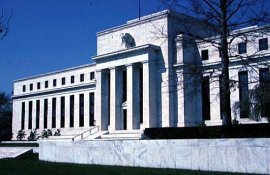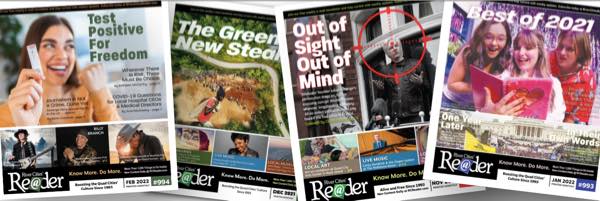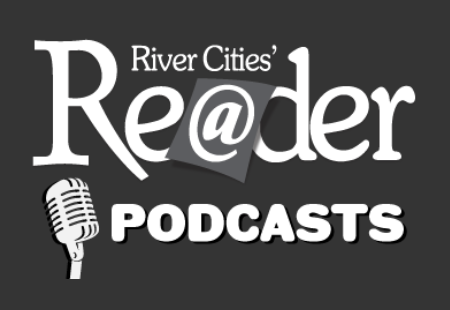 February 4, 2009's cover story - The Future of Money?: With the Economy a Wreck, Alternative Currencies Could Gain Traction - explores local and national currency systems that have emerged as alternatives to Federal Reserve Notes - commonly known as U.S. dollar bills. It is my firm belief that the Federal Reserve system - with its fractional reserve lending, lack of accountability to the people (via Congress) and the market (via price fixing of interest rates) - is going lead to the total devaluation our currency and the destruction of our nation's economy. What will fill that vacuum, without these alternative currencies, is subject for another column.
February 4, 2009's cover story - The Future of Money?: With the Economy a Wreck, Alternative Currencies Could Gain Traction - explores local and national currency systems that have emerged as alternatives to Federal Reserve Notes - commonly known as U.S. dollar bills. It is my firm belief that the Federal Reserve system - with its fractional reserve lending, lack of accountability to the people (via Congress) and the market (via price fixing of interest rates) - is going lead to the total devaluation our currency and the destruction of our nation's economy. What will fill that vacuum, without these alternative currencies, is subject for another column.
[June 5, 2009: Since this was published the Federal Reserve Transparency Act of 2009 has been introduced by Congressman Ron Paul and co-sponsored by over 180 House members from both sides of the duopoly, Republicans and Democrats. Even if the bill passes the house it faces a royal battle from the Senate, who is even more so in the pockets of the banksters on Wall Street,with such senate luminaries in finance as Chris Dodd and Chuck Grassely.]
Thomas Jefferson said, "The system of banking [is] a blot left in all our Constitutions, which, if not covered, will end in their destruction. ... I sincerely believe that banking institutions are more dangerous than standing armies; and that the principle of spending money to be paid by posterity ... is but swindling futurity on a large scale."
[Note: This 3 minute clip from the HBO documentary "John Adams" does not contain a reenactment of this exact quote. But it does deftly illustrate Jefferson's position and the context which would have informed such a statement.]
The $1 trillion "stimulus" package - where do you think that money comes from? The government creates no wealth. When the Fed prints more money out of thin air, not only does it devalue the dollars in your pocket immediately, it further burdens us and several generations beyond with the interest due on such notes by the U.S. Treasury. That is why we are forced to pay the federal income tax - in order to pay off the national debt. It is coercion of the highest order, and unfortunately the vast majority of Americans are too busy consuming to take note.
Last fall, finance guru Jim "Mad Money" Cramer stated, "You know I am no fan of the Federal Reserve these days. You know that I think the Fed has hurt this stock market and this U.S. economy. Frankly, I think the Federal Reserve has run amok. It's become totally unaccountable."
And last week, Fox News talk-show host Glen Beck produced a segment called "An Inconvenient Debt" in which he illustrated - Al Gore slideshow style - how many new dollars and how much inflation the Federal Reserve is currently generating. The graphic effect should be staggering to all who watch it.
How did we come to this? In 1913, Congress voted to hand over its constitutional authority to "coin money and regulate the value thereof" to a consortium of private banks via the Federal Reserve Act. Congress exercises little to no oversight over the Fed's activities. The 12 regional Federal Reserve Banks are owned by the member banks who buy shares in it.
All nationally chartered banks and bank-holding companies are by default member banks of the Federal Reserve System. Just a few of the powerful banks that are owners of the Federal Reserve District Banks: Goldman Sachs Bank, Bank of America, and Morgan Stanley. In the '60s, JFK attempted to return America to a sliver-backed sound-money system with executive order 11110. We see how well that worked out for him. And in the '70s, under Nixon, we decided to forego the gold standard, promising the world we would not print too much money so as to devalue it. So, you see, the Federal Reserve is neither federal nor is it reserve.
Of course the Fed disagrees and claims otherwise. From its own Web site (FederalReserve.gov/generalinfo/faq/faqfrs.htm):
[NOTE: As of March 29, 2023 this link above has no content, the publisher has removed. The archive of that page is available at www.rcreader.com/y/fed6.]
"Who owns the Federal Reserve? The 12 regional Federal Reserve Banks, which were established by Congress as the operating arms of the nation's central banking system, are organized much like private corporations - possibly leading to some confusion about 'ownership.' For example, the Reserve Banks issue shares of stock to member banks. However, owning Reserve Bank stock is quite different from owning stock in a private company. The Reserve Banks are not operated for profit, and ownership of a certain amount of stock is, by law, a condition of membership in the System. The stock may not be sold, traded, or pledged as security for a loan; dividends are, by law, 6 percent per year."
Six percent dividend by law? Pretty good work if you can get it. But let's not haggle over semantics. According to Alan Greenspan, former Fed chair, "The Federal Reserve is an independent agency, and that means, basically, that there is no other agency of government which can overrule actions that we take."
In addition to asset-backed competing currencies, there is remedy to all this: a bill presented by U.S. Representative Ron Paul in 2007, the Federal Reserve Board Abolition Act (House Resolution 2755). The full body of this bill, as well as video clips of the persons cited here (except Thomas Jefferson) and supporting links can be found at RCReader.com.
NOTE: Since this article was published in February 2009, Congressman Paul has introduced HR 1207 The Federal Reserve Transparancy Act of 2009.
As of this update (June 5, 2009), the bill has over 180 co-sponsors from both sides of the duoparty.








